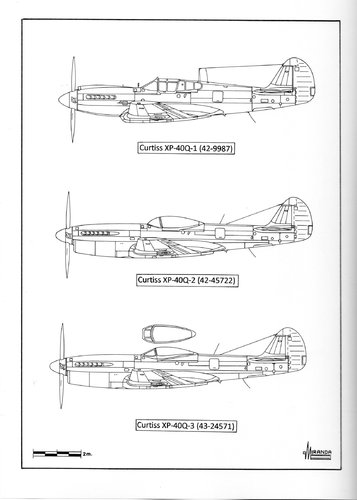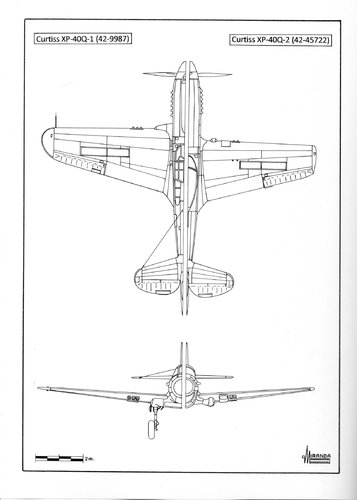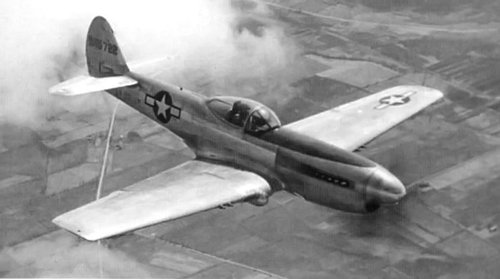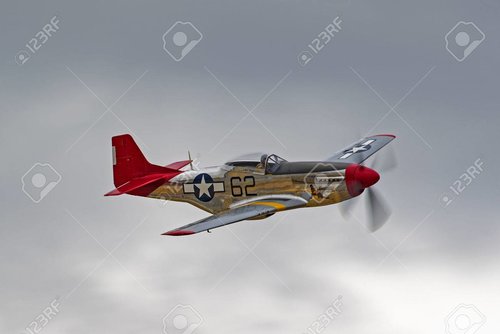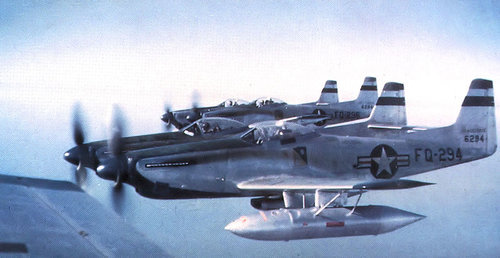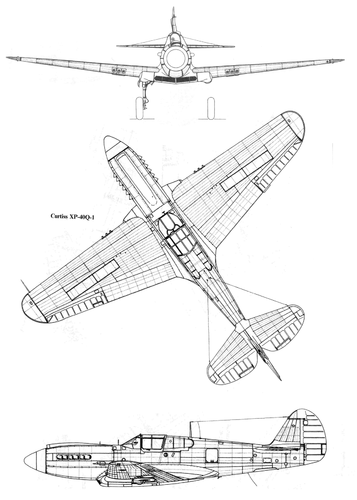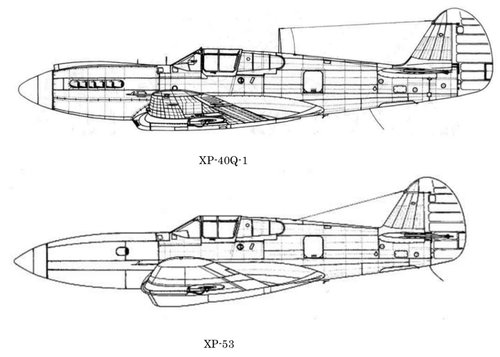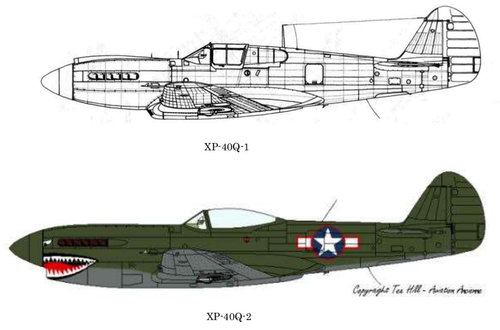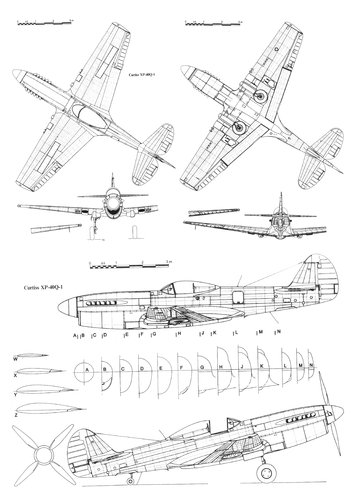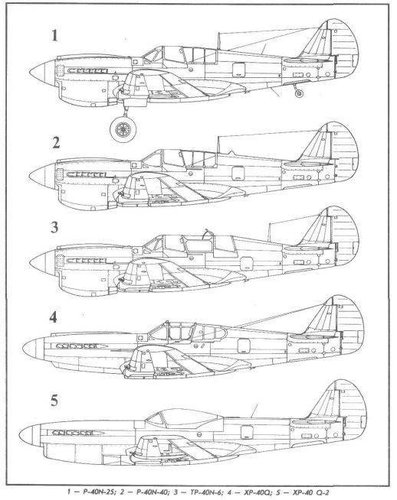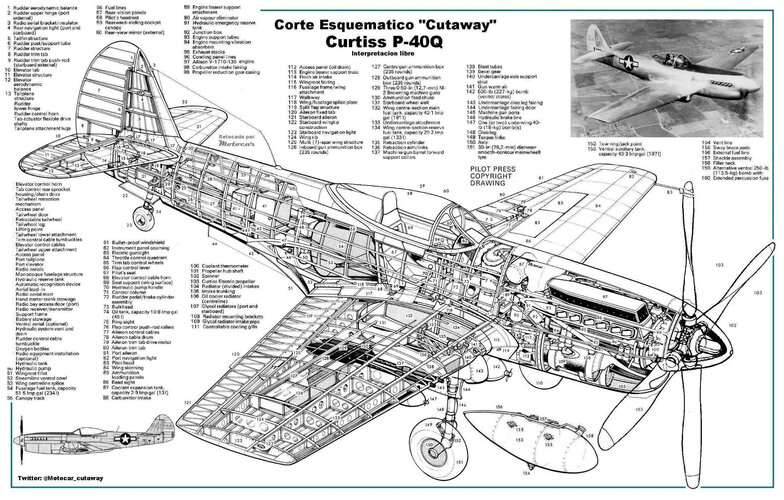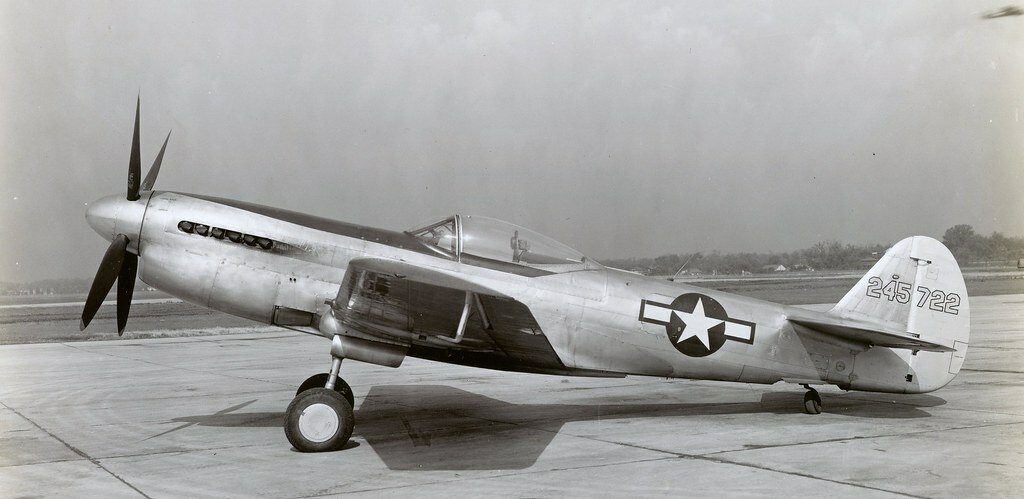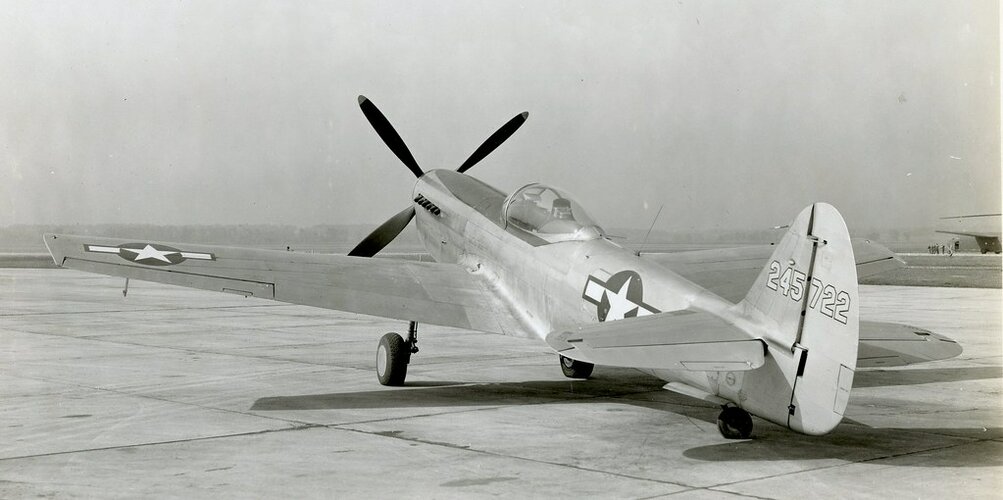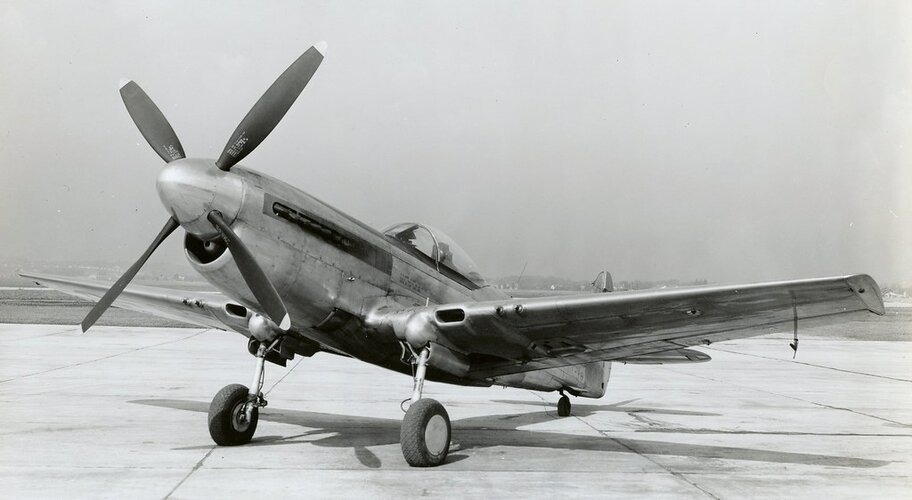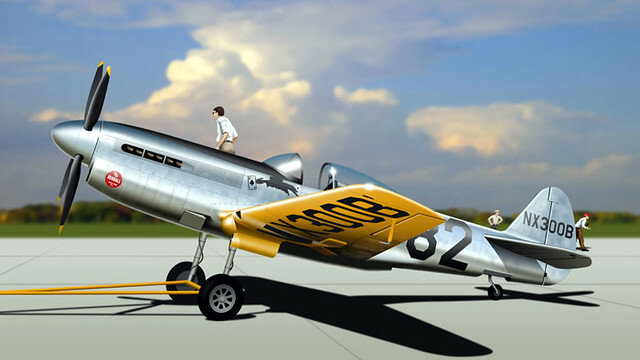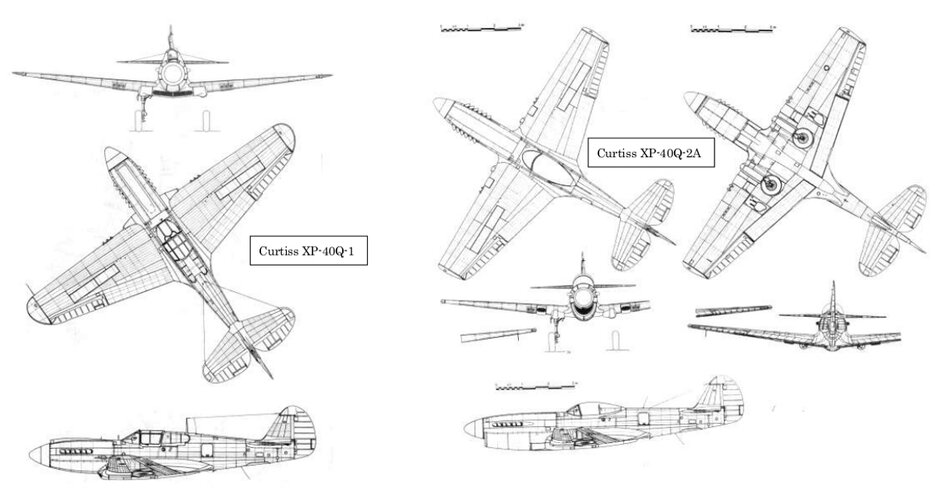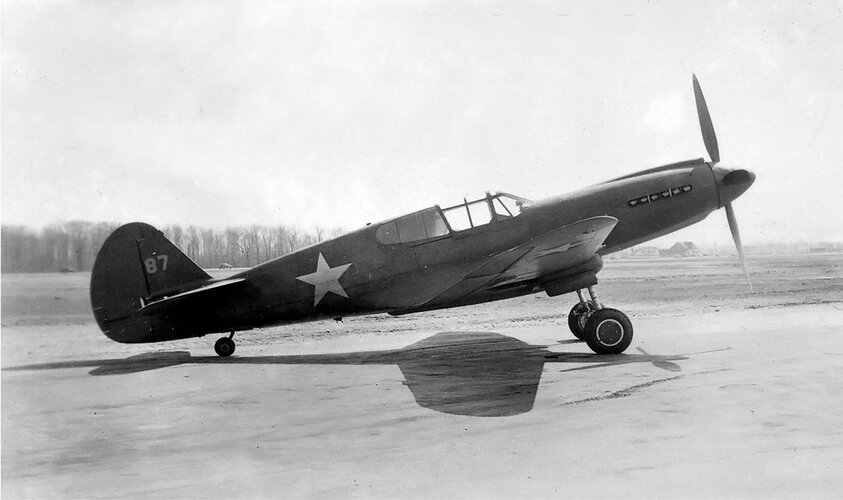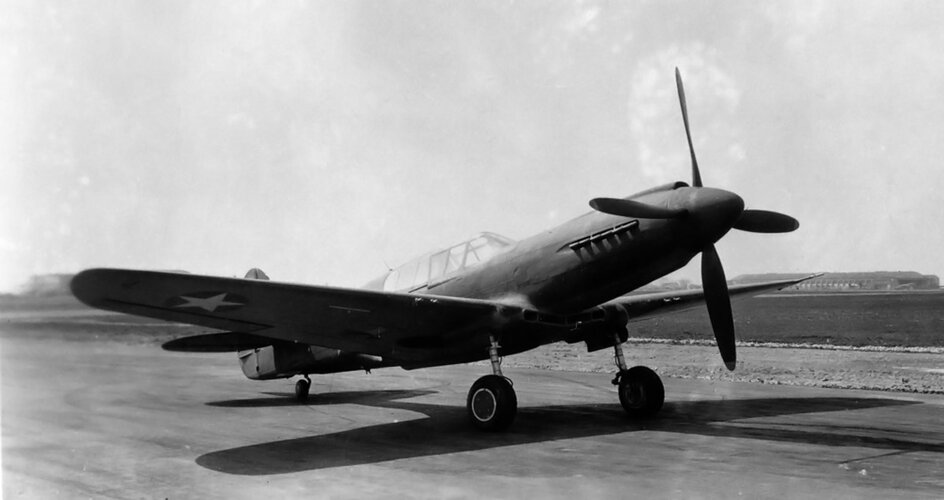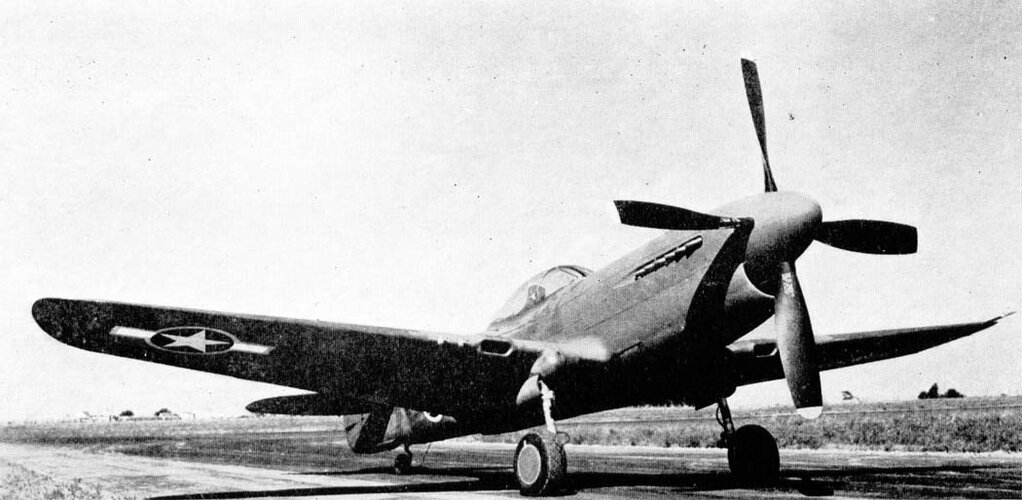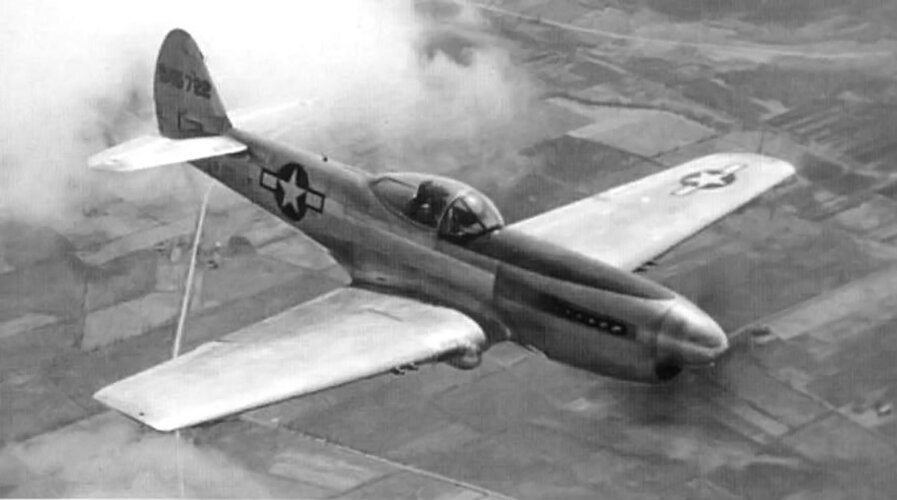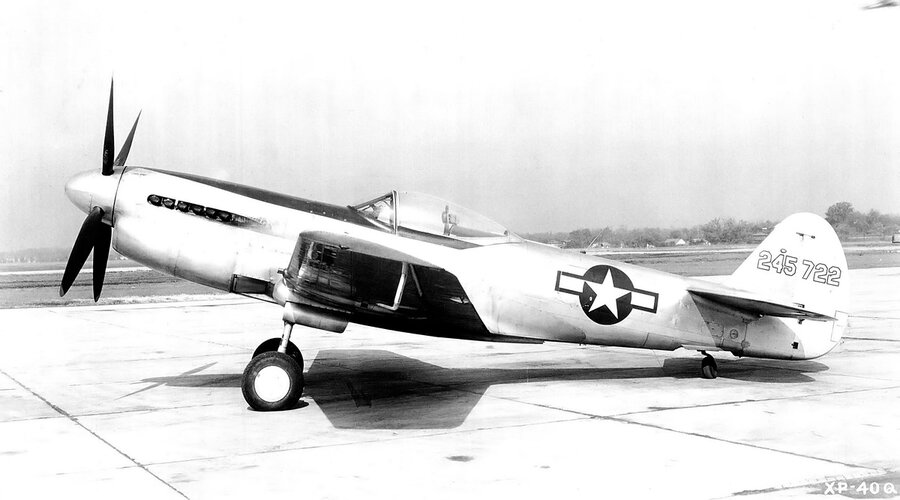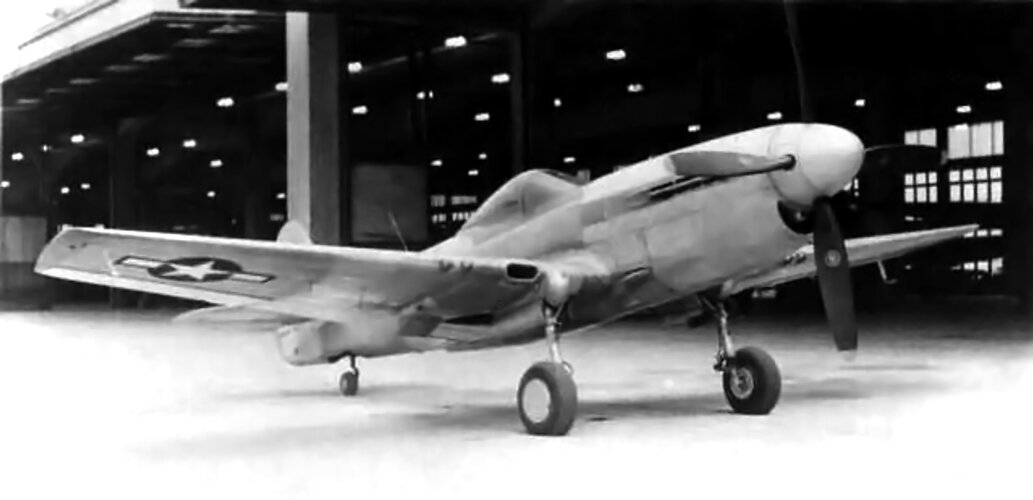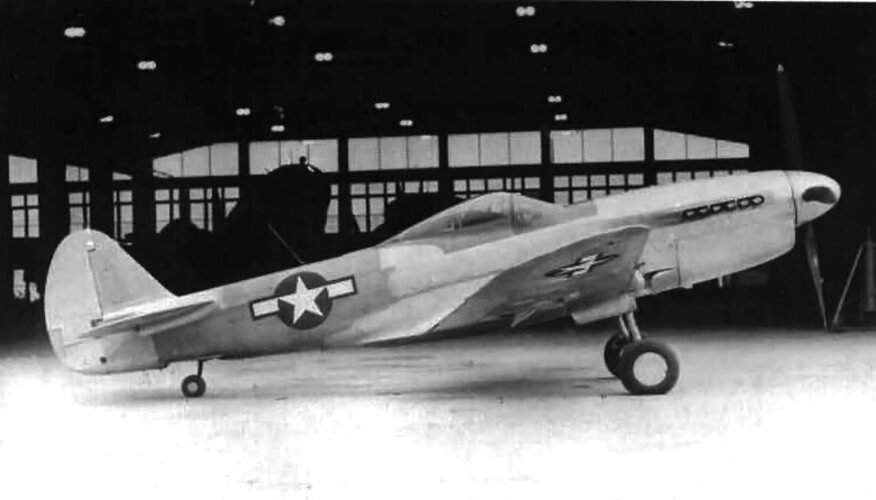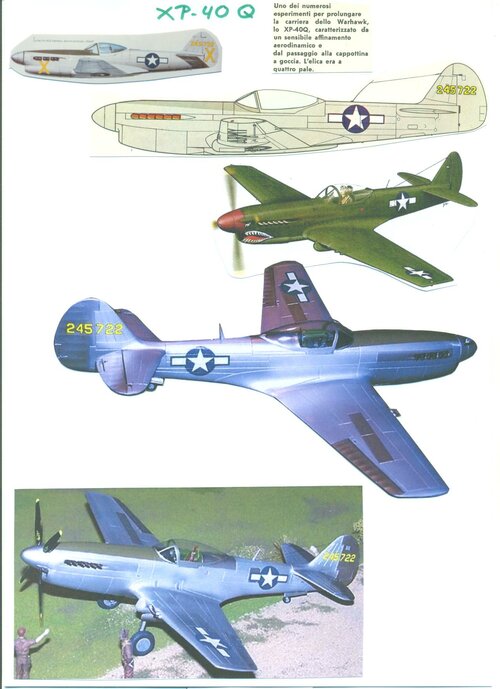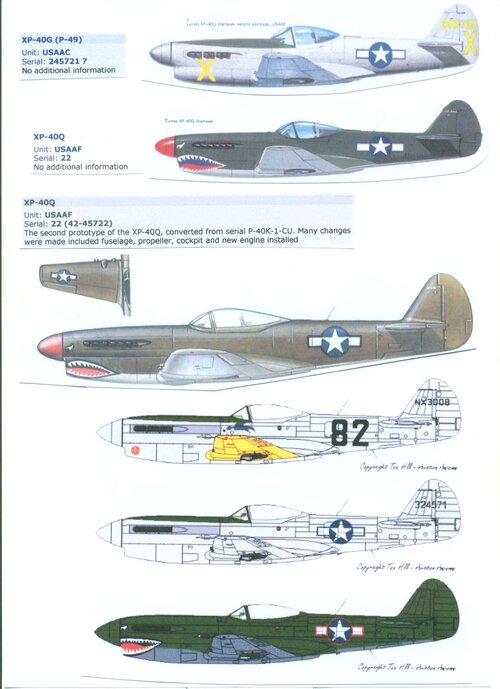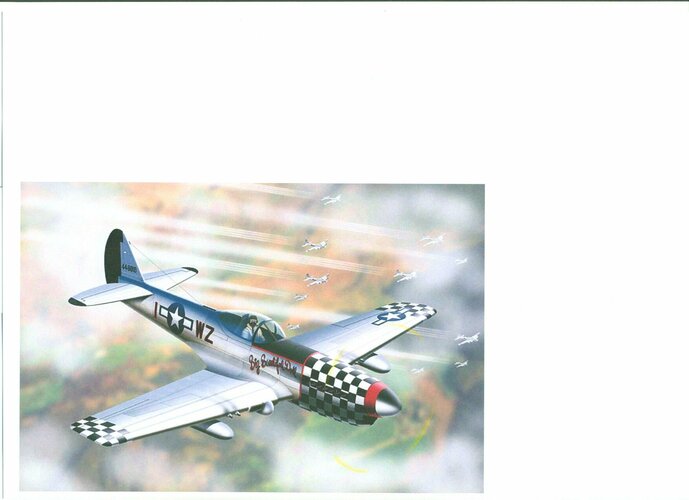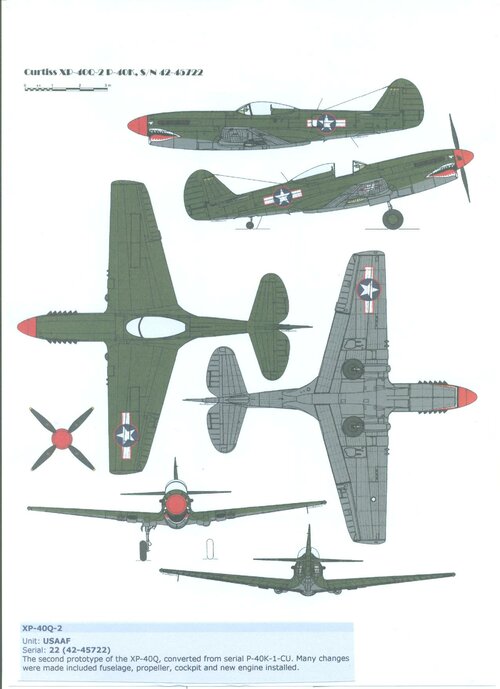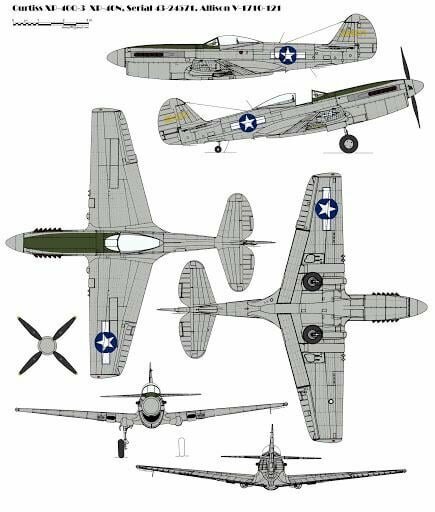You are using an out of date browser. It may not display this or other websites correctly.
You should upgrade or use an alternative browser.
You should upgrade or use an alternative browser.
Curtiss P-40Q
- Thread starter Justo Miranda
- Start date
blackkite
Don't laugh, don't cry, don't even curse, but.....
- Joined
- 31 May 2007
- Messages
- 8,819
- Reaction score
- 7,716
XP-40Q:
A prototype that has been thoroughly improved, such as retrofit to the V-1710-121 equipped with a two-stage supercharger, water droplet type windshield equipment, and cooling system update.
It is the p-40's highest performance model with a top speed of 680km/h, but it was not adopted because it does not reach the new aircraft such as the P-51.
A prototype that has been thoroughly improved, such as retrofit to the V-1710-121 equipped with a two-stage supercharger, water droplet type windshield equipment, and cooling system update.
It is the p-40's highest performance model with a top speed of 680km/h, but it was not adopted because it does not reach the new aircraft such as the P-51.
Last edited:
blackkite
Don't laugh, don't cry, don't even curse, but.....
- Joined
- 31 May 2007
- Messages
- 8,819
- Reaction score
- 7,716
Hi!
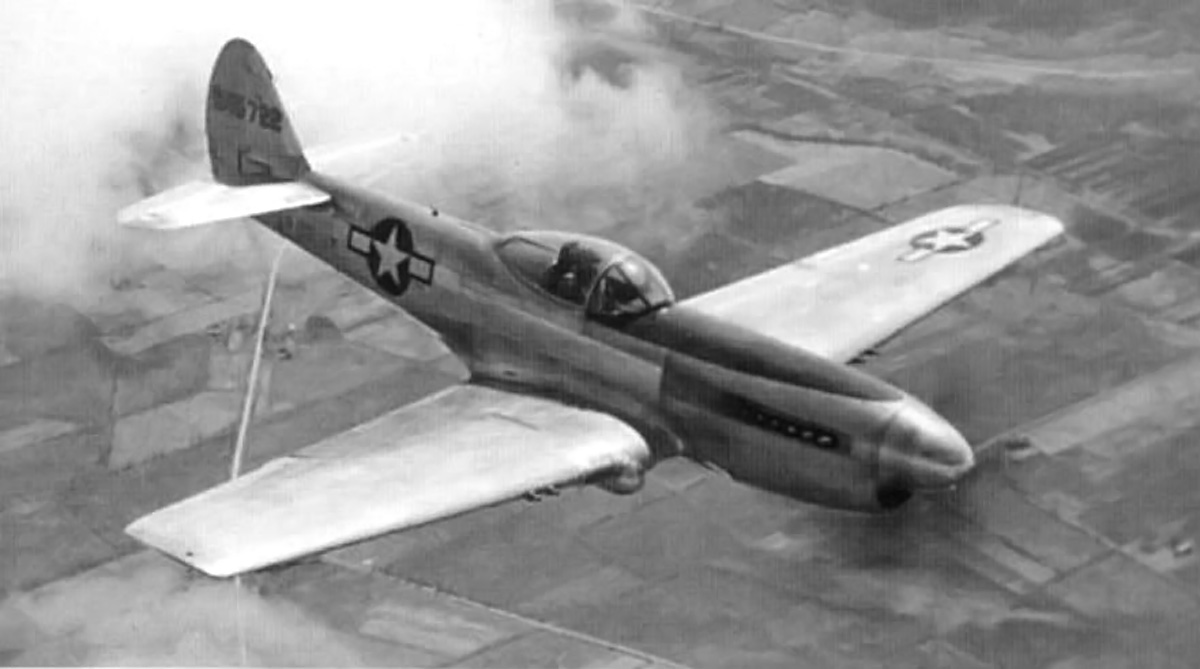
 oldmachinepress.com
"There is no indication that any of the XP-40Q aircraft used any type of a laminar flow wing."
oldmachinepress.com
"There is no indication that any of the XP-40Q aircraft used any type of a laminar flow wing."
"the two-stage Allison engines would not have been ready, as they were still having developmental trouble in 1944."

Curtiss XP-40Q Fighter
The XP-40Q was a final attempt by Curtiss to extend the life of its P-40 fighter design. While it was a good aircraft, the XP-40Q was on par or outclassed by other fighters already in production.
"the two-stage Allison engines would not have been ready, as they were still having developmental trouble in 1944."
Attachments
Last edited:
windswords
ACCESS: Secret
- Joined
- 19 May 2009
- Messages
- 389
- Reaction score
- 217
Found this quote somewhere (don't remember):
Barrie Davis, P-51 pilot, 325th Fighter Group
"New pilots coming to our fighter group were invariably cocky to the point they were dangerous to themselves. They thought the Luftwaffe was finished and that the P-51 could quickly and easily kill anything else that flew. To modify the attitude of the newcomers, we used a war weary P-40 which our squadron somehow acquired. I was in charge of putting new pilots through a quick, intensive training program, and the final flight included a mock dogfight with the new pilot of a P-51 pitted against one of us flying a P-40. I can tell you that until a pilot knows the strengths and weaknesses of both airplanes, the P-40 can make the P-51 look outclassed. Using all of the P-40s strengths, an innovative pilot could out fly a P-51 at low altitudes until the P-51 jockey finally realized that there was something more to fighting in the air than *simply having the best airplane*. At that point the new pilot would become ready to listen to everything we had to say".
So the P-40, like the Ki-100 was very good in the low to medium altitudes. Imagine what the XP-40Q might have done had it been produced as a "supplement" to the high altitude P-38, P-47 and P-51s...
Barrie Davis, P-51 pilot, 325th Fighter Group
"New pilots coming to our fighter group were invariably cocky to the point they were dangerous to themselves. They thought the Luftwaffe was finished and that the P-51 could quickly and easily kill anything else that flew. To modify the attitude of the newcomers, we used a war weary P-40 which our squadron somehow acquired. I was in charge of putting new pilots through a quick, intensive training program, and the final flight included a mock dogfight with the new pilot of a P-51 pitted against one of us flying a P-40. I can tell you that until a pilot knows the strengths and weaknesses of both airplanes, the P-40 can make the P-51 look outclassed. Using all of the P-40s strengths, an innovative pilot could out fly a P-51 at low altitudes until the P-51 jockey finally realized that there was something more to fighting in the air than *simply having the best airplane*. At that point the new pilot would become ready to listen to everything we had to say".
So the P-40, like the Ki-100 was very good in the low to medium altitudes. Imagine what the XP-40Q might have done had it been produced as a "supplement" to the high altitude P-38, P-47 and P-51s...
Found this quote somewhere (don't remember):
Barrie Davis, P-51 pilot, 325th Fighter Group
"New pilots coming to our fighter group were invariably cocky to the point they were dangerous to themselves. They thought the Luftwaffe was finished and that the P-51 could quickly and easily kill anything else that flew. To modify the attitude of the newcomers, we used a war weary P-40 which our squadron somehow acquired. I was in charge of putting new pilots through a quick, intensive training program, and the final flight included a mock dogfight with the new pilot of a P-51 pitted against one of us flying a P-40. I can tell you that until a pilot knows the strengths and weaknesses of both airplanes, the P-40 can make the P-51 look outclassed. Using all of the P-40s strengths, an innovative pilot could out fly a P-51 at low altitudes until the P-51 jockey finally realized that there was something more to fighting in the air than *simply having the best airplane*. At that point the new pilot would become ready to listen to everything we had to say".
So the P-40, like the Ki-100 was very good in the low to medium altitudes. Imagine what the XP-40Q might have done had it been produced as a "supplement" to the high altitude P-38, P-47 and P-51s...
Wow. Old' P-40 used to teach modesty to P-51 drivers - what a delightful irony !!
The stall onset is more sudden due to reduced airfoil curvature on the laminar plateau.
In effect you have less sign to warn you that the wing itself is about to stall.
Reciprocally, this wing characteristic, made recovery quicker.
With the P-51, the interactions b/w tailplane and wing's flow gave plenty of warning at the onset of stall (buffet).
Perhaps that the reported increase number of incidents during takeoffs and landings were due to the heavier takeoffs with reversed pitch sensitivity and the long duration of the missions...
See p24:
In effect you have less sign to warn you that the wing itself is about to stall.
Reciprocally, this wing characteristic, made recovery quicker.
With the P-51, the interactions b/w tailplane and wing's flow gave plenty of warning at the onset of stall (buffet).
Perhaps that the reported increase number of incidents during takeoffs and landings were due to the heavier takeoffs with reversed pitch sensitivity and the long duration of the missions...
See p24:
Last edited:
windswords
ACCESS: Secret
- Joined
- 19 May 2009
- Messages
- 389
- Reaction score
- 217
Perhaps that the reported increase number of incidents during takeoffs and landings were due to the heavier takeoffs with reversed pitch sensitivity and the long duration of the missions...
All fighters, even the good ones, have strengths and weaknesses. For the Mustang one is the fuselage tank(s). It was added sometime after the prototype. A similar thing was done to later marks of the Spitfire. Both had the same effect: it messed the airplanes center of gravity, and the tank had to be drained at least partially before anything more than gentle maneuvers could be tried.
I have a quote somewhere from another pilot whose group switched from P-47s to P-51s. A pilot took the new plane up and wasn't told about the issue with the fuselage tank. He got into a spin he could not recover from and luckily was able to bail out.
Last edited:
I remember an interview of Stephen Grey reacting to comments on how he flew the Pony at airshows being boring.
He explained that the P-51 can't be manoeuvered securely at slow speed as a Spit or a 109, due to the laminar flow wing. Hence, fast straigh passes, and wide turns, or manoeuvers in the vertical with lot of energy.
If you ever played some combat flight sims with resonable accurate flight simulation engine, say like the old TargetWare (Anyone remember that one?) or DSC, you will find that engaging a turning fight flying a P-51 is really not the thing to do. Can think of it as had to be flown like a jet, before the jets.
Not surprising the P-40 (which is not as bad a fighter) could succeed in a slow and low turning fight against it.
Funny thing, when you realize that AVG had to use fast boom and zoom tactics with the P-40 , against Ki-27 and 43 and the A6Ms in Asia.
He explained that the P-51 can't be manoeuvered securely at slow speed as a Spit or a 109, due to the laminar flow wing. Hence, fast straigh passes, and wide turns, or manoeuvers in the vertical with lot of energy.
If you ever played some combat flight sims with resonable accurate flight simulation engine, say like the old TargetWare (Anyone remember that one?) or DSC, you will find that engaging a turning fight flying a P-51 is really not the thing to do. Can think of it as had to be flown like a jet, before the jets.
Not surprising the P-40 (which is not as bad a fighter) could succeed in a slow and low turning fight against it.
Funny thing, when you realize that AVG had to use fast boom and zoom tactics with the P-40 , against Ki-27 and 43 and the A6Ms in Asia.
Last edited:
(from memory) wasn't the P-51 wing re-used on the first Fury - the FJ-1 naval jet (not the British Fury with a propeller)?
Some also said the Spitfire elliptical wing had different qualities than the laminar one, and in the end the two were evenly matched in pros and cons.
(Bill Gunston in a very old book listing WWII fighters).
Some also said the Spitfire elliptical wing had different qualities than the laminar one, and in the end the two were evenly matched in pros and cons.
(Bill Gunston in a very old book listing WWII fighters).
Yes, I you look at a early FJ-1 Fury plan , you see P-51 wings, fin, tailplane matted to a new fuselage containing the jet engine. They could have called it "Jet-Mustang".
Not sure if the wings were derived from the P-51D or from the late H though. But it was the same laminar flow anyway, not really good for low speed.
From P-51 to F-86 is interesting cause it's a incremental evolution from the Fast but Low alt P-51A with Allison, then Fast and High P-51 B/C/D and Hs with Merlin, then even faster FJ-1 with jet, to finish with the Sabre going even faster with swept wings.
Not sure if the wings were derived from the P-51D or from the late H though. But it was the same laminar flow anyway, not really good for low speed.
From P-51 to F-86 is interesting cause it's a incremental evolution from the Fast but Low alt P-51A with Allison, then Fast and High P-51 B/C/D and Hs with Merlin, then even faster FJ-1 with jet, to finish with the Sabre going even faster with swept wings.
Last edited:
The P-51 wing was thicker than most of regular airfoils of fighter aircraft of the time (15%). This help greatly in the range of speed you are talking about and explains the Mustang good performances.
Probably that Grey had eyes mostly for the Spitfire (which had the thinner airfoil of any mass produced WWII prop fighters at 12%). This attitude doesn't help much.
The point that makes laminar wings of the time a bit tricky is their more sudden transition from slow speed flight to stall than a regular airfoil (boundary layer transition). However, North American aviation made a great deal of work to give their pilot plenty of warning by tuning the horizontal plane buffeting response.
There is around the evaluation report of the Mustang flown against both the Spitfire and the P-40.
For the French reader, Le Fana made a great story (J. Ethell) starting with issue nbr310.
Probably that Grey had eyes mostly for the Spitfire (which had the thinner airfoil of any mass produced WWII prop fighters at 12%). This attitude doesn't help much.
The point that makes laminar wings of the time a bit tricky is their more sudden transition from slow speed flight to stall than a regular airfoil (boundary layer transition). However, North American aviation made a great deal of work to give their pilot plenty of warning by tuning the horizontal plane buffeting response.
There is around the evaluation report of the Mustang flown against both the Spitfire and the P-40.
For the French reader, Le Fana made a great story (J. Ethell) starting with issue nbr310.
Last edited:
As noted, he real key is understanding a specific aircrafts characteristics. North American test pilot Bob Hoover put together a demonstration of the P-51's low altitude, low speed capabilities. I believe there are some videos available as Hoover performed the demonstrations at many airshows. If you are interested in the issues discussed in this thread, you should find a copy and see just what a skilled and knowledgeable pilot could do.
Best Regards,
ArtieBob
Best Regards,
ArtieBob
1Big Rich
ACCESS: Confidential
Found this quote somewhere (don't remember):
Barrie Davis, P-51 pilot, 325th Fighter Group
"New pilots coming to our fighter group were invariably cocky to the point they were dangerous to themselves. They thought the Luftwaffe was finished and that the P-51 could quickly and easily kill anything else that flew. To modify the attitude of the newcomers, we used a war weary P-40 which our squadron somehow acquired. I was in charge of putting new pilots through a quick, intensive training program, and the final flight included a mock dogfight with the new pilot of a P-51 pitted against one of us flying a P-40. I can tell you that until a pilot knows the strengths and weaknesses of both airplanes, the P-40 can make the P-51 look outclassed. Using all of the P-40s strengths, an innovative pilot could out fly a P-51 at low altitudes until the P-51 jockey finally realized that there was something more to fighting in the air than *simply having the best airplane*. At that point the new pilot would become ready to listen to everything we had to say".
So the P-40, like the Ki-100 was very good in the low to medium altitudes. Imagine what the XP-40Q might have done had it been produced as a "supplement" to the high altitude P-38, P-47 and P-51s...
A great pilot in a good plane is always more dangerous than a good pilot in a great plane!
Thanks for that; most interesting.
The now-defunct CC Jordan website on World War 2 fighter is preserved by WebArchive
But regarding the P-40, there is an interesting piece from China pilot Erik Shilling
As an aside, there is some interesting stuff there. One of the P-38 pieces has a letter from a Col. Rau that details what a P-38 pilot had to go through in a 'bounce' situation. It makes me wonder if a Merlin P-38 would have alleviated some of those issues...
Regards,
taildragger
You can count on me - I won a contest
- Joined
- 2 November 2008
- Messages
- 404
- Reaction score
- 502
In 2016, Jeffery Pino - the former president of Sikorsky, and a passenger were killed while performing acrobatics in a 2-seat P-51. Room for the second seat was, of course, created by removing the fuselage tank and, when occupied, it recreated the same old CG problem.Also, some of those accidents on take-off were the result of using the fuselage tank behind the cockpit, which made the P-51 slightly unstable when fully loaded.
windswords
ACCESS: Secret
- Joined
- 19 May 2009
- Messages
- 389
- Reaction score
- 217
I think the P-40Q might have been a good "export" fighter. One that you sell to other countries that you don't want to have your latest hardware and also is cheap enough for them to buy. But I don't think that concept was known then and anyhow, with the end of WWII coming there was more than enough surplus aircraft to go around. Shame though it might have helped to sustain Curtiss-Wright a few more years at least.
Temistocle
ACCESS: Secret
- Joined
- 9 December 2009
- Messages
- 245
- Reaction score
- 504
I found in the SDASM Flickr webiste a couple of pictures of the first P-40Q:


From the Joe Baugher website, this is the first P-40Q, derived from a P-40K-10-CU (S.N. 42-9987) fitted with a new cooling system, a longer nose, and a four-bladed propeller. The radiators were moved into an under-fuselage position, with intakes between the undercarriage legs. The armamant was reducedd to four 0.50 M2 guns.
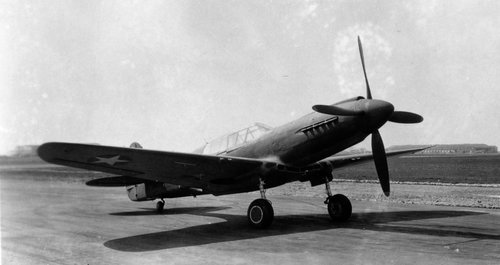
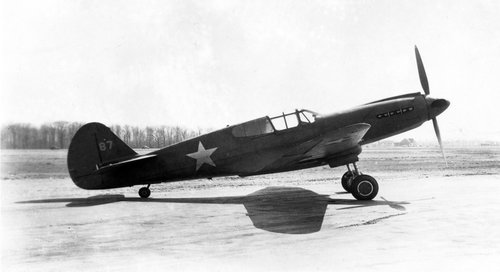
From the Joe Baugher website, this is the first P-40Q, derived from a P-40K-10-CU (S.N. 42-9987) fitted with a new cooling system, a longer nose, and a four-bladed propeller. The radiators were moved into an under-fuselage position, with intakes between the undercarriage legs. The armamant was reducedd to four 0.50 M2 guns.
According to Dean & Hagedorn, and based on Dean's collection of Curtiss and USAAF documents, the XP-40Q-1 designation wasn't used,
just -2, -2A and -3.
XP-40Q-2 (modified P-40K-10 42-9987) which existed in two configurations: without the nose scoop, wing radiators and standard canopy;
it was rebuilt with a nose scoop, bubble canopy and clipped wings.
XP-40Q-2A (modified P-40K-1 42-45722), this was the first production P-40K.
XP-40Q-3 (modified P-40N-25 43-24571).
Q-2 and Q-2A were listed as P-40Ks in Air Force records, the Q-3 was the only one listed as XP-40Q from the start.
The XP-40Q-2/-2A/-3 designations were appended by Curtiss and the Flight Test Engineering Branch at Wright Field.
just -2, -2A and -3.
XP-40Q-2 (modified P-40K-10 42-9987) which existed in two configurations: without the nose scoop, wing radiators and standard canopy;
it was rebuilt with a nose scoop, bubble canopy and clipped wings.
XP-40Q-2A (modified P-40K-1 42-45722), this was the first production P-40K.
XP-40Q-3 (modified P-40N-25 43-24571).
Q-2 and Q-2A were listed as P-40Ks in Air Force records, the Q-3 was the only one listed as XP-40Q from the start.
The XP-40Q-2/-2A/-3 designations were appended by Curtiss and the Flight Test Engineering Branch at Wright Field.
blackkite
Don't laugh, don't cry, don't even curse, but.....
- Joined
- 31 May 2007
- Messages
- 8,819
- Reaction score
- 7,716
Attachments
I found in the SDASM Flickr webiste a couple of pictures of the first P-40Q:
View attachment 638185
View attachment 638186
From the Joe Baugher website, this is the first P-40Q, derived from a P-40K-10-CU (S.N. 42-9987) fitted with a new cooling system, a longer nose, and a four-bladed propeller. The radiators were moved into an under-fuselage position, with intakes between the undercarriage legs. The armamant was reducedd to four 0.50 M2 guns.
Gorgeous aircraft, really. And one can see, at a glance, why it would perform much better than the standard P-40: the hugely draggy radiator is gone. This simple fact certainly helped a lot...
I think the P-40Q might have been a good "export" fighter. One that you sell to other countries that you don't want to have your latest hardware and also is cheap enough for them to buy. But I don't think that concept was known then and anyhow, with the end of WWII coming there was more than enough surplus aircraft to go around. Shame though it might have helped to sustain Curtiss-Wright a few more years at least.
Good point. Shame indeed they couldn't pull a "F-5A / F-5E" with this one - that is, a low cost but efficient alternative to the top fighter of the era (Mustang / Phantom, or P-47 / F-104, alternatively).
Imagine if the Nationalist chinese had large numbers of this aircraft against the Japanese, circa 1943-44...
blackkite
Don't laugh, don't cry, don't even curse, but.....
- Joined
- 31 May 2007
- Messages
- 8,819
- Reaction score
- 7,716
Hi! XP-40Q-1?
https://live.warthunder.com/user/Ariodante/
https://live.warthunder.com/user/Ariodante/
Attachments
<snip>
I think the P-40Q might have been a good "export" fighter. One that you sell to other countries that you don't want to have your latest hardware and also is cheap enough for them to buy. But I don't think that concept was known then and anyhow, with the end of WWII coming there was more than enough surplus aircraft to go around. Shame though it might have helped to sustain Curtiss-Wright a few more years at least.
Good point. Shame indeed they couldn't pull a "F-5A / F-5E" with this one - that is, a low cost but efficient alternative to the top fighter of the era (Mustang / Phantom, or P-47 / F-104, alternatively).
Imagine if the Nationalist chinese had large numbers of this aircraft against the Japanese, circa 1943-44...
I'm not sure that there was any demand for export fighters or any real concern about cost at that point.
When the P-40Q appeared, the US war economy was cranked up for maximum production of its latest, front-line types, all of which were equal or superior to enemy craft and available in large enough numbers to supply US allies alongside USAAF and USN units. The P-40 was old technology, at that point, being essentially a re-engined P-36. As a potential export aircraft, the P-40Q would have no advantages in contemporary terms and some very large disadvantages. Introducing the required changes into production would complicate planning, reduce the supply of superior aircraft in demand by US forces, and make maintenance and supply chains that much harder to manage.
Curtiss-Wright was an equally old-fashioned company, with a string of drawn-out, failed development efforts behind it. It was already showing signs of its post-war collapse. So I doubt the USAAF would have found it an attractive development partner, even if the "new" design was mostly old.
I believe that Mustangs were replacing P-47's for cost reasons (1/3?), and these Mustangs were much more vulnerable to enemy fire with their dangling radiators/intercoolers.
The U.S. had plenty of pilots in the pipeline while the Axis didn't have gas to train new ones.
In other words, without such a clear numeric superiority, the U.S. might have considered keeping the sturdier P-40 design around longer. It was apparently very popular in the Pacific for that reason.
An American pilot also wrote that he never flew two Mustangs with the same behavior, as the laminar flow wing was very sensitive to any ding or dent in its surface (His words might have been "a gnat on the leading edge").
What would have been the result with poorly trained young pilots rushed to the Front Lines? The British knew about it when sending kids to Tempest squadrons.
The U.S. had plenty of pilots in the pipeline while the Axis didn't have gas to train new ones.
In other words, without such a clear numeric superiority, the U.S. might have considered keeping the sturdier P-40 design around longer. It was apparently very popular in the Pacific for that reason.
An American pilot also wrote that he never flew two Mustangs with the same behavior, as the laminar flow wing was very sensitive to any ding or dent in its surface (His words might have been "a gnat on the leading edge").
What would have been the result with poorly trained young pilots rushed to the Front Lines? The British knew about it when sending kids to Tempest squadrons.
windswords
ACCESS: Secret
- Joined
- 19 May 2009
- Messages
- 389
- Reaction score
- 217
I believe that Mustangs were replacing P-47's for cost reasons (1/3?)
The number I heard was 1.5 Mustangs for each Thunderbolt and 2 Mustangs for each Lightning. Republic did not get any cancellations because they needed the P-47s for close air support. Not wanting to be left out of the long range escort market they developed the P-47N which had a longer max range than the P-51D and did the P-38L, but both would use more gas than the P-51 for the same distance.
windswords
ACCESS: Secret
- Joined
- 19 May 2009
- Messages
- 389
- Reaction score
- 217
When the P-40Q appeared, the US war economy was cranked up for maximum production of its latest, front-line types, all of which were equal or superior to enemy craft and available in large enough numbers to supply US allies alongside USAAF and USN units.
My comment was about the immediate post war, not during the war and I addressed the production issue: "... with the end of WWII coming there was more than enough surplus aircraft to go around".
Your point about Curtiss-Wright's lack of technological prowess and failed development efforts is well taken. Even if there had been an immediate post war export market it would have at best staved off their eventual collapse.
I didn't read closely enough and missed the post-war context. Sorry about that.My comment was about the immediate post war, not during the war and I addressed the production issue: "... with the end of WWII coming there was more than enough surplus aircraft to go around".
Your point about Curtiss-Wright's lack of technological prowess and failed development efforts is well taken. Even if there had been an immediate post war export market it would have at best staved off their eventual collapse.
That said, I'm not sure that any high-performance piston-engined export fighter made much sense given the realities of the post-war world.
America's principle allies against the Soviet Union and China (the NATO countries, Taiwan, etc.) needed jets that could take on Soviet jets on equal terms.
America's third-world allies were believed to face a different kind of threat: subversion by international Communism disguised as internal insurgencies. Washington did not want these allies fighting each other over their various, long-established, mutual grievances and ignoring the supposed real danger. So surplus fighter bombers were handed out mainly because they were available. Armed T-6 trainers and, later, T-28s were seen as better suited to the role.
High-performance, military piston engines like the Merlin, the Allison, and even the turbocharged R-2800 also turned out to be too complex and expensive for these allies, to maintain, particularly once WW2-vintage USAF parts stocks began to dwindle following the Korean War. Even France, a sophisticated ally, faced supply challenges with its F4Us and the AD-4s, which at least had engines still in widespread commercial as well as military use. The Allison and Merlin never achieved any significant commercial market and thus no readily available sources of supply, training, and expertise. T-6 and T-28 trainer engines were, in contrast, comparatively easy to maintain and parts remained available from military, military surplus, and purely commercial sources.
blackkite
Don't laugh, don't cry, don't even curse, but.....
- Joined
- 31 May 2007
- Messages
- 8,819
- Reaction score
- 7,716
Attachments
Last edited:
blackkite
Don't laugh, don't cry, don't even curse, but.....
- Joined
- 31 May 2007
- Messages
- 8,819
- Reaction score
- 7,716
Hi!

 forum.warthunder.com
forum.warthunder.com
Please check diagram of this brog.

Curtiss XP-40Q-2A Warhawk - Ultimate Super Warhawk
poll Curtiss XP-40Q-2A Warhawk Hello everybody. I’d like to introduce and suggest the Curtiss XP-40Q-2A Warhawk for USA Aviation, and this is my final suggestion for the P-40 variants in the US Army Air Corps and US Army Air Force services. The XP-40Q-2A prototype was an experimental...
 forum.warthunder.com
forum.warthunder.com
Please check diagram of this brog.
Attachments
-
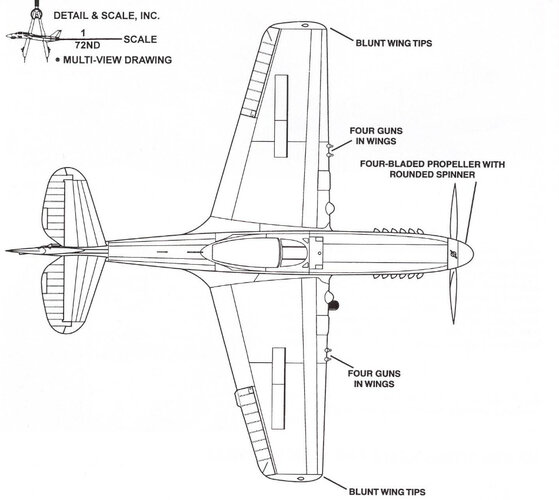 030d2d2d41ccd9bee454324db16238ad5e046d5a.jpeg110.1 KB · Views: 90
030d2d2d41ccd9bee454324db16238ad5e046d5a.jpeg110.1 KB · Views: 90 -
 66cbecca81ff886e2a7996f5a0bc29d7270ab8c8.jpeg119.2 KB · Views: 82
66cbecca81ff886e2a7996f5a0bc29d7270ab8c8.jpeg119.2 KB · Views: 82 -
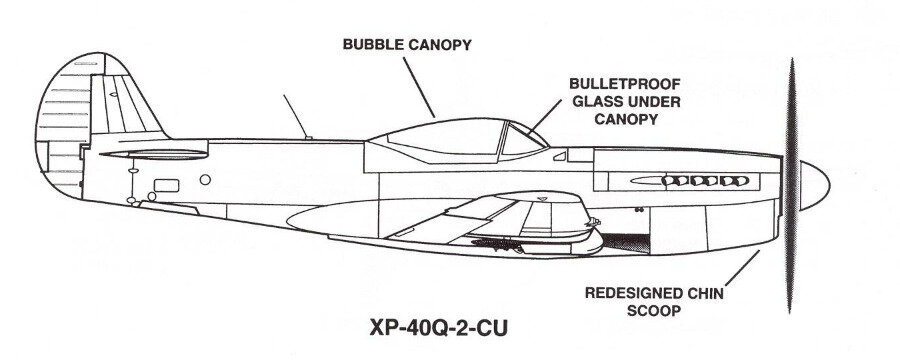 720b975c63a6ad7cee490cf2a77e2ceb37a9b0b8.jpeg53.7 KB · Views: 82
720b975c63a6ad7cee490cf2a77e2ceb37a9b0b8.jpeg53.7 KB · Views: 82 -
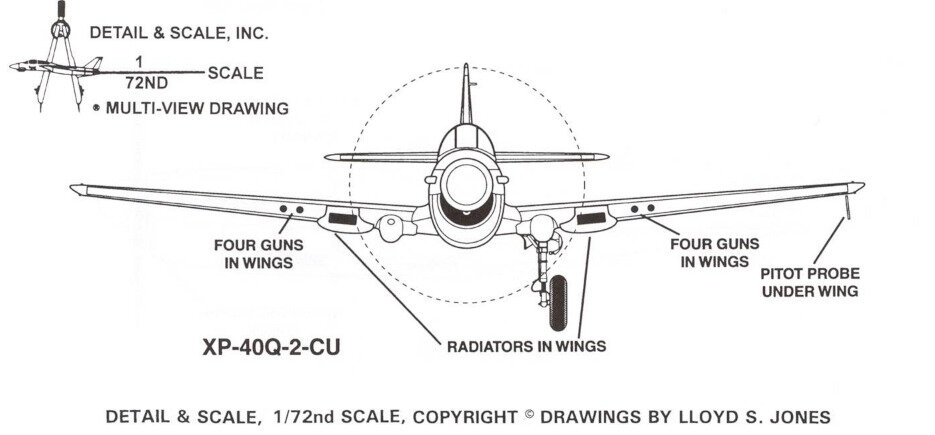 898d02a3a9c96596f77e573e037100e938f76ce0.jpeg58.8 KB · Views: 83
898d02a3a9c96596f77e573e037100e938f76ce0.jpeg58.8 KB · Views: 83 -
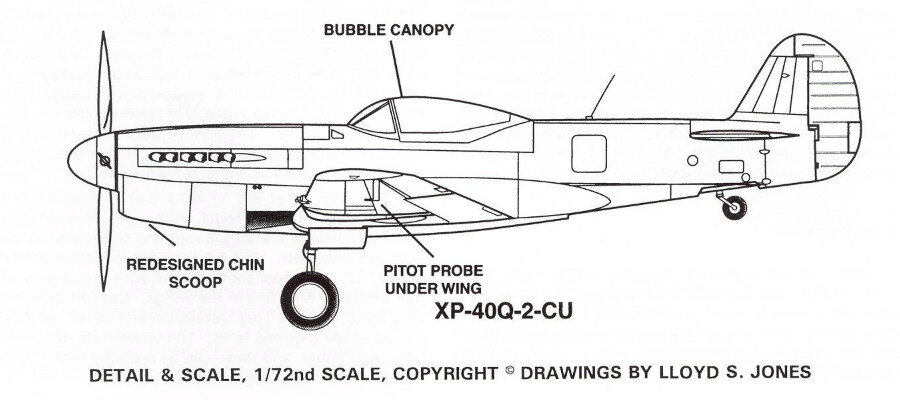 f92ac8239ea79dfc31516ed60f4c8b05eaf7e664.jpeg74.8 KB · Views: 83
f92ac8239ea79dfc31516ed60f4c8b05eaf7e664.jpeg74.8 KB · Views: 83 -
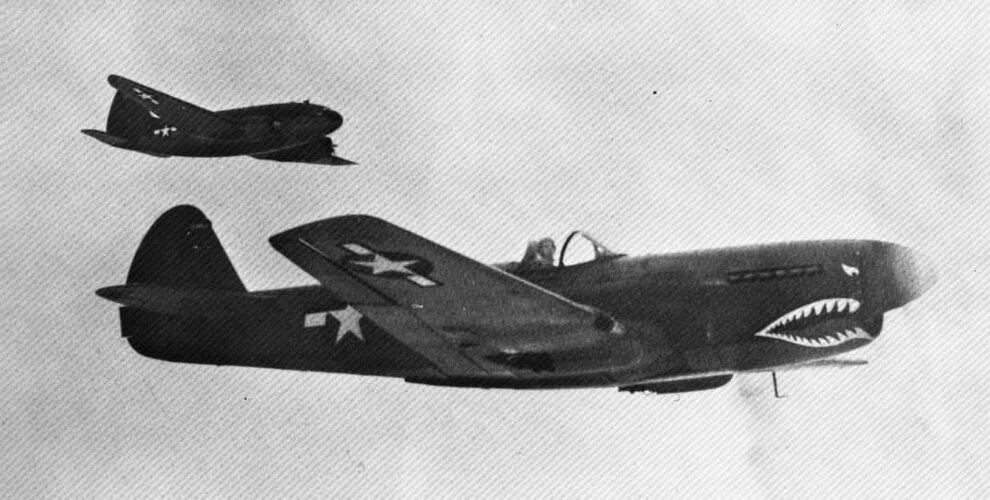 ffa2240e6e9d8a92ec8fcd010108cbdc09e69947.jpeg60.4 KB · Views: 81
ffa2240e6e9d8a92ec8fcd010108cbdc09e69947.jpeg60.4 KB · Views: 81
The main concern of the ground attack pilots was the German ‘hit-and-run’ tactic and the low rearward view of the P-40 was partially improved in the P-40 N series with the modification of the canopy. In 1944 the P-40 N-25 s/n 43-24571 was modified, as the XP-40 N prototype, with a cut-down rear fuselage, a new windshield and a full-view teardrop canopy.
Another attempt to reduce drag was the installation in the prototype XP-40 K-10-CU s/n 42-10219 of two radiators located in the thickened centre section of the wing. The airplane was powered by one V-1650-1 Merlin engine, with two-stage supercharger.
Curtiss attempted several programmes to increase the performance of the P-40, but all failed in the end.
Early 1943 the P-40 K-10-CU s/n 42-9987 was modified as the XP-40 Q-1, a higher performance version with several aerodynamic refinements and much improved cowl lines, but retaining the partially exposed, rear-folding, landing gear.
The power was increased with the installation of one 1,325 hp Allison V-1710-101 engine, with two-stage supercharger, driving a four-bladed propeller. Two semi-flush low-drag radiators and one oil cooler were enclosed in the central section of the wing. The airplane was flown on 13 June 1943.
By November the prototype had been modified, as XP-40 Q-2, the rear fuselage was cut down and a teardrop canopy, with curved windshield, was installed. The oil cooler and the engine air scoop were moved to the chin position and the two radiators were repositioned in the wings.
The USAAF Air Materiel Command recommended that two additional prototypes be constructed.
In January 1944 the XP-40 Q-2 had its wingtips clipped and one Allison V-1710-121 engine rated at 1,425 hp (1,800 hp with water injection) was installed.
Curtiss XP-40 Q-1 technical data
Power plant: one 1,325 hp Allison V-1710-101 engine, with two-stage supercharger, driving a four-bladed propeller, wingspan: 37.3 ft (11.38 m), length: 35.4 ft (10.8 m), height: 10.9 ft (3.32 m), wing area: 243.5 sq. ft (21.92 sq. m).
Curtiss XP-40 Q-2 technical data
Power plant: one 1,425 hp Allison V-1710-121 engine, with two-stage supercharger, driving a four-bladed propeller, wingspan: 35.1 ft (10.7 m), length: 35.4 ft (10.8 m), height: 10.9 ft (3.32 m), max speed: 422 mph (679 kph), max weight: 9,000 lbs (4,082 kg), service ceiling: 39,000 ft (11,887 m), armament: four wing mounted 0.50 cal machine guns.
The P-40 K-1 s/n 42-45722 was modified as the XP-40 Q-2A prototype, with more streamlined canopy and flat windshield. The aircraft was flown end of March 1944 and the trials revealed similar performance to those of the XP-40 Q-2.
In April 1944 made its first flight the XP-40 Q-3 (ex-P-40 N-25-CU s/n 43-24571) with modifications and performance similar to those of the XP-40 Q-2.
The aircraft had a smaller canopy with longer windscreen and suffered several engine failures.
Even with these modifications the XP-40 Q was still inferior to the contemporary production North American P-51 fighter and the proposed production version P-40 Q, with six 0.50 cal machine guns or four 20 mm M3 cannons, never built.
Another attempt to reduce drag was the installation in the prototype XP-40 K-10-CU s/n 42-10219 of two radiators located in the thickened centre section of the wing. The airplane was powered by one V-1650-1 Merlin engine, with two-stage supercharger.
Curtiss attempted several programmes to increase the performance of the P-40, but all failed in the end.
Early 1943 the P-40 K-10-CU s/n 42-9987 was modified as the XP-40 Q-1, a higher performance version with several aerodynamic refinements and much improved cowl lines, but retaining the partially exposed, rear-folding, landing gear.
The power was increased with the installation of one 1,325 hp Allison V-1710-101 engine, with two-stage supercharger, driving a four-bladed propeller. Two semi-flush low-drag radiators and one oil cooler were enclosed in the central section of the wing. The airplane was flown on 13 June 1943.
By November the prototype had been modified, as XP-40 Q-2, the rear fuselage was cut down and a teardrop canopy, with curved windshield, was installed. The oil cooler and the engine air scoop were moved to the chin position and the two radiators were repositioned in the wings.
The USAAF Air Materiel Command recommended that two additional prototypes be constructed.
In January 1944 the XP-40 Q-2 had its wingtips clipped and one Allison V-1710-121 engine rated at 1,425 hp (1,800 hp with water injection) was installed.
Curtiss XP-40 Q-1 technical data
Power plant: one 1,325 hp Allison V-1710-101 engine, with two-stage supercharger, driving a four-bladed propeller, wingspan: 37.3 ft (11.38 m), length: 35.4 ft (10.8 m), height: 10.9 ft (3.32 m), wing area: 243.5 sq. ft (21.92 sq. m).
Curtiss XP-40 Q-2 technical data
Power plant: one 1,425 hp Allison V-1710-121 engine, with two-stage supercharger, driving a four-bladed propeller, wingspan: 35.1 ft (10.7 m), length: 35.4 ft (10.8 m), height: 10.9 ft (3.32 m), max speed: 422 mph (679 kph), max weight: 9,000 lbs (4,082 kg), service ceiling: 39,000 ft (11,887 m), armament: four wing mounted 0.50 cal machine guns.
The P-40 K-1 s/n 42-45722 was modified as the XP-40 Q-2A prototype, with more streamlined canopy and flat windshield. The aircraft was flown end of March 1944 and the trials revealed similar performance to those of the XP-40 Q-2.
In April 1944 made its first flight the XP-40 Q-3 (ex-P-40 N-25-CU s/n 43-24571) with modifications and performance similar to those of the XP-40 Q-2.
The aircraft had a smaller canopy with longer windscreen and suffered several engine failures.
Even with these modifications the XP-40 Q was still inferior to the contemporary production North American P-51 fighter and the proposed production version P-40 Q, with six 0.50 cal machine guns or four 20 mm M3 cannons, never built.
Attachments
blackkite
Don't laugh, don't cry, don't even curse, but.....
- Joined
- 31 May 2007
- Messages
- 8,819
- Reaction score
- 7,716
Hi!

 oldmachinepress.com
oldmachinepress.com

Curtiss XP-40Q Fighter
The XP-40Q was a final attempt by Curtiss to extend the life of its P-40 fighter design. While it was a good aircraft, the XP-40Q was on par or outclassed by other fighters already in production.
Attachments
Post-2
Attachments
-
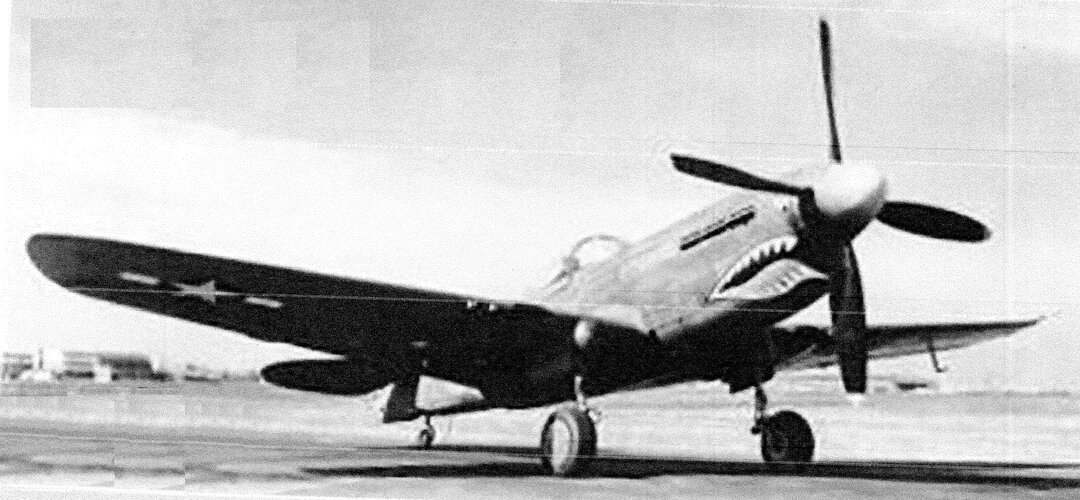 img20241019_10195396.jpg1.1 MB · Views: 53
img20241019_10195396.jpg1.1 MB · Views: 53 -
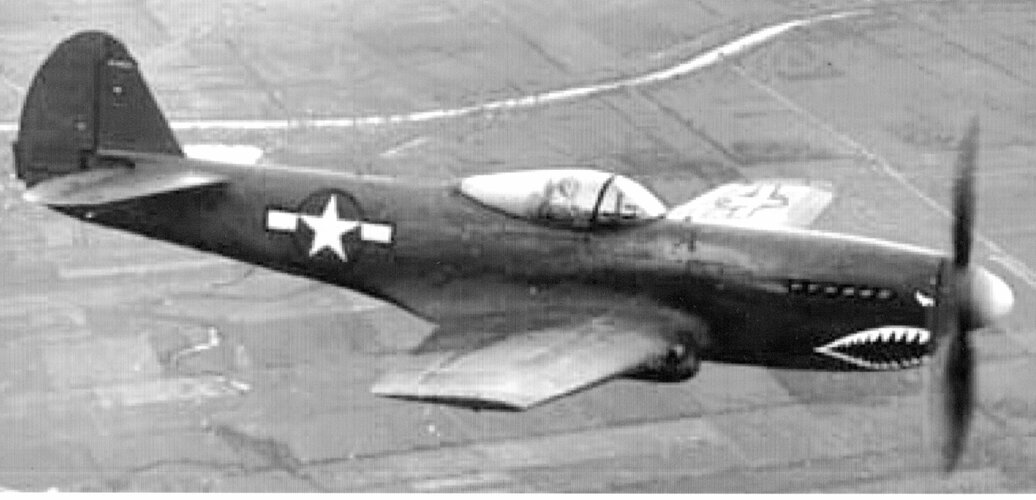 img20241019_10231232.jpg420.5 KB · Views: 54
img20241019_10231232.jpg420.5 KB · Views: 54 -
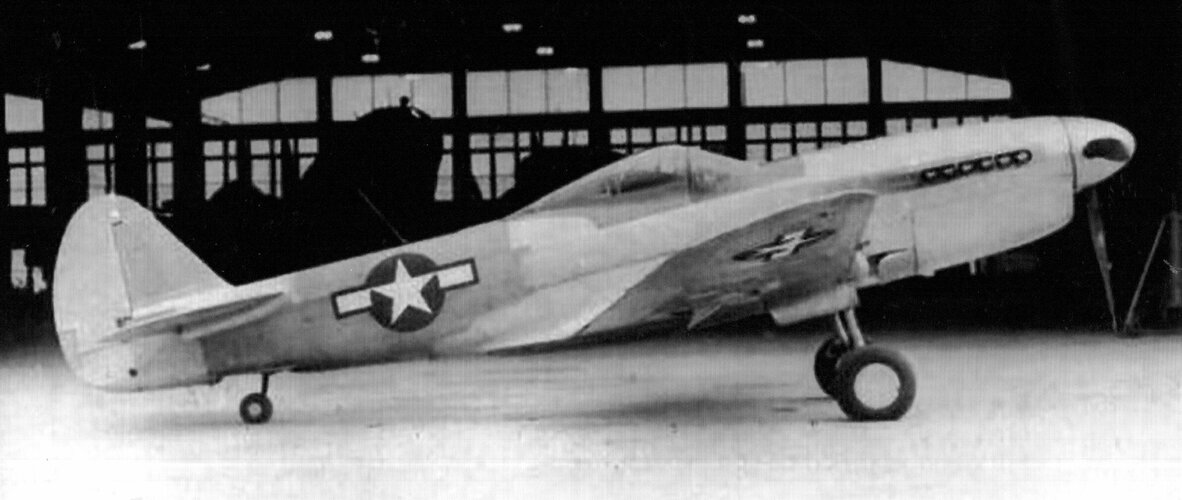 img20241019_10240595.jpg359.9 KB · Views: 52
img20241019_10240595.jpg359.9 KB · Views: 52 -
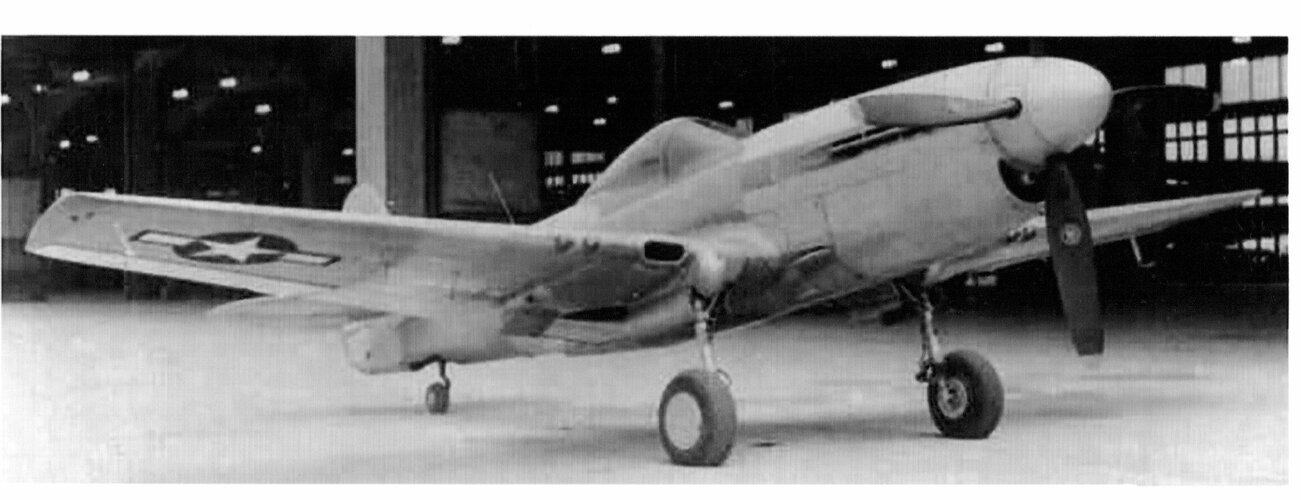 img20241019_10251042.jpg296.4 KB · Views: 45
img20241019_10251042.jpg296.4 KB · Views: 45 -
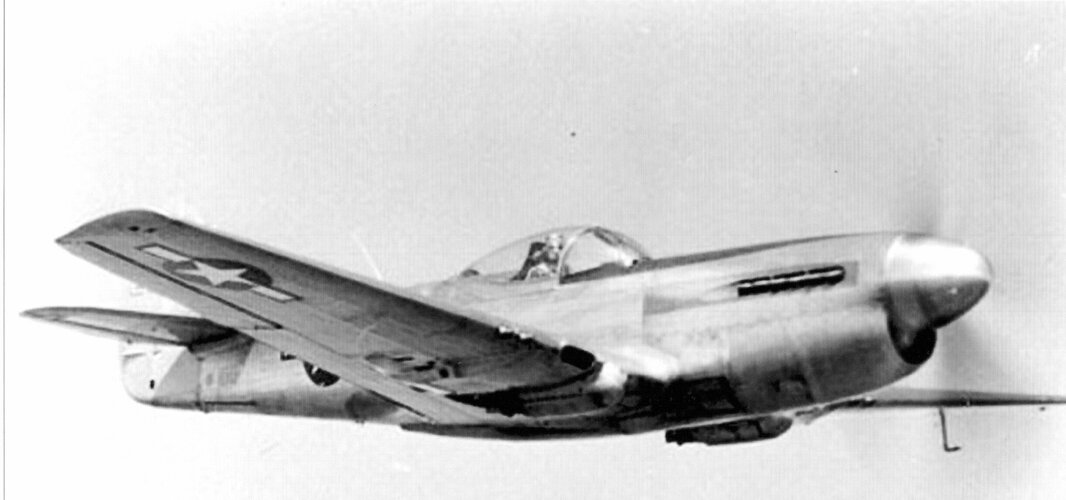 img20241019_10261140.jpg293.3 KB · Views: 49
img20241019_10261140.jpg293.3 KB · Views: 49 -
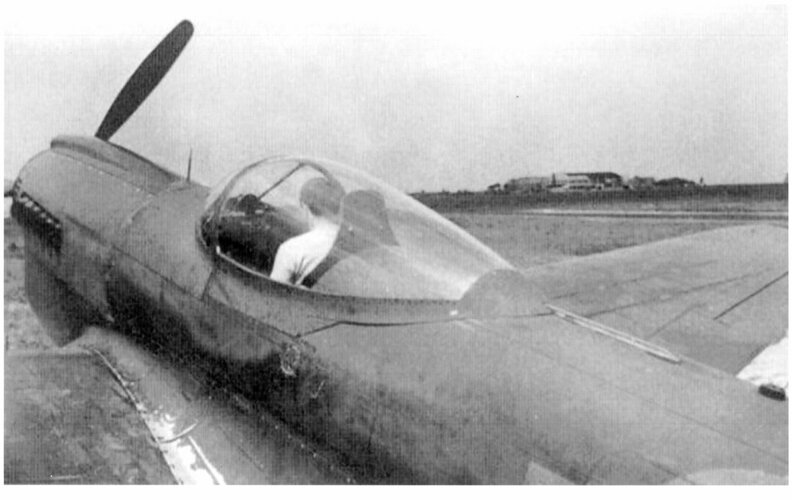 img20241019_10270785.jpg507.3 KB · Views: 47
img20241019_10270785.jpg507.3 KB · Views: 47 -
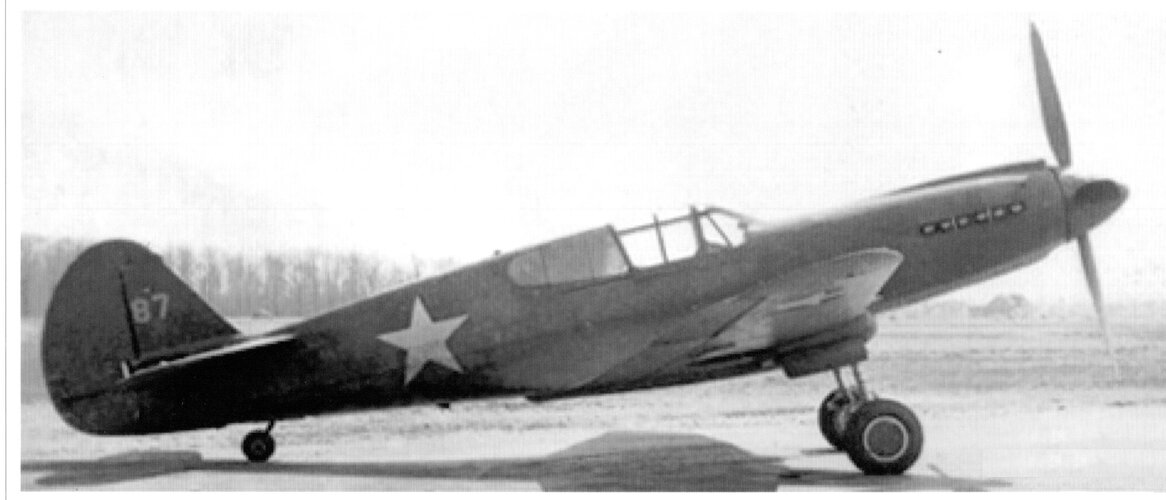 img20241019_10280418.jpg500.8 KB · Views: 47
img20241019_10280418.jpg500.8 KB · Views: 47 -
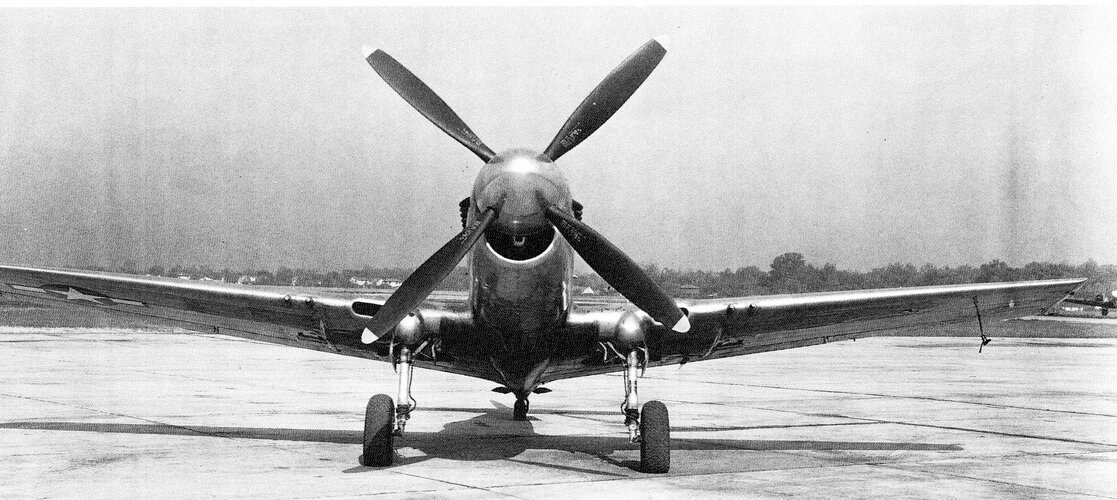 img20241019_10321230.jpg1.2 MB · Views: 41
img20241019_10321230.jpg1.2 MB · Views: 41 -
 img20241019_10323785.jpg341.6 KB · Views: 47
img20241019_10323785.jpg341.6 KB · Views: 47 -
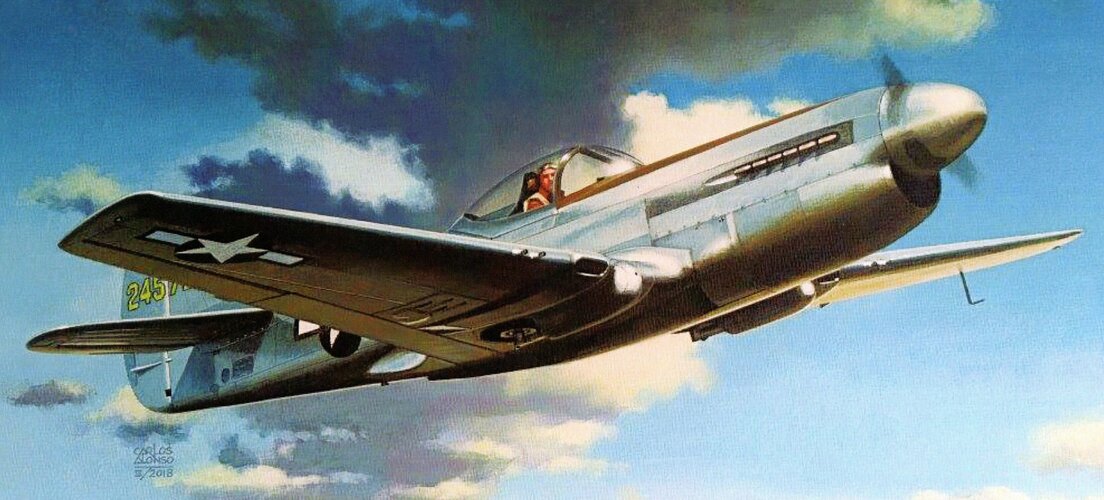 img20241019_10365299.jpg1.4 MB · Views: 57
img20241019_10365299.jpg1.4 MB · Views: 57
_Del_
I really should change my personal text... Or not.
- Joined
- 4 January 2012
- Messages
- 1,315
- Reaction score
- 1,811
The Commando was pretty handy.One of the few, if not the only one, decent aircraft Curtiss produced post P-36 / P-40. Everything else was garbage.
Similar threads
-
-
-
-
Curtiss-Wright "Model 24" (actually P-240), a four-engine "Commando"
- Started by Mark Nankivil
- Replies: 7
-

